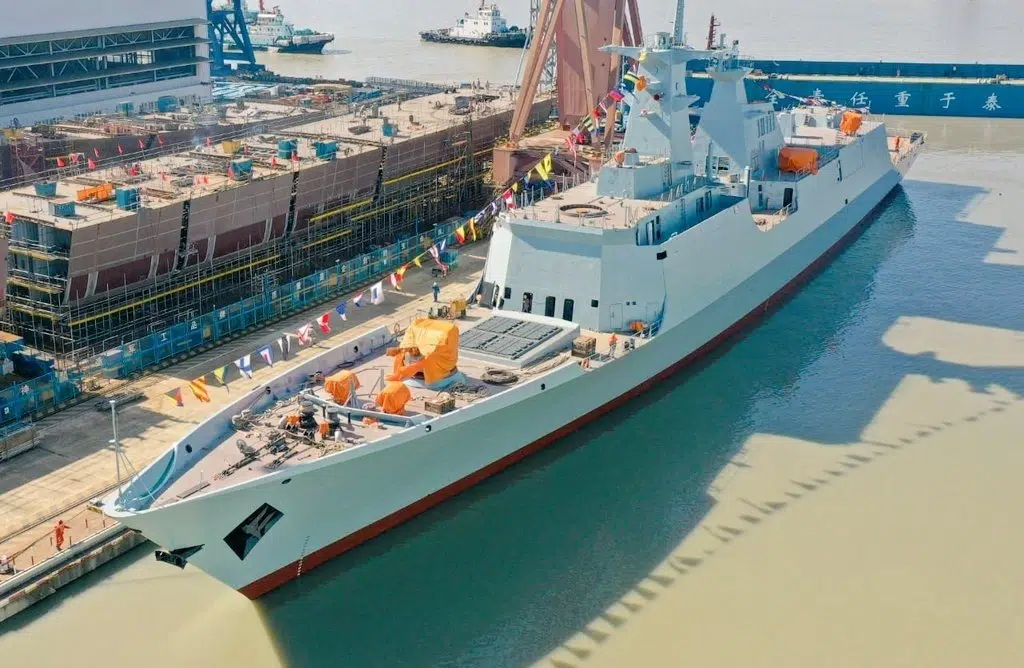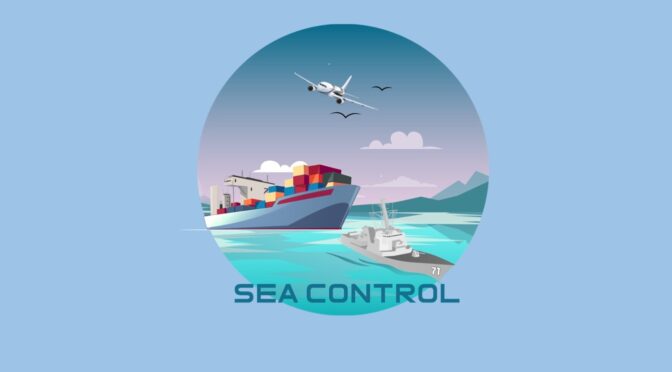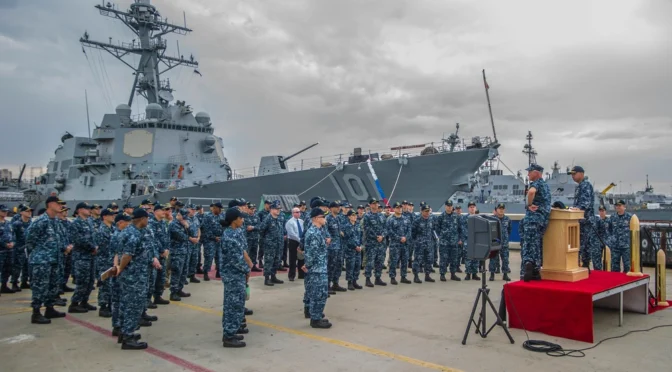By Slade Woodard
The Line of Control still dominates the nightly news, yet war between India and Pakistan could spill seaward. In early May 2025, the two nuclear‑armed neighbors again traded strikes, suspended bilateral trade concessions, and placed elements of their fleets on alert.1 Nearly one‑third of Pakistan’s import bill, and, critically, 16 percent of its food supply, arrives by sea.2 With roughly 60 percent of that traffic funneling through the single port complex of Karachi, the question is no longer whether the coast matters, but how maritime leverage could shape the next crisis.
One should reassess the naval dimension of an Indo‑Pakistani conflict through four lenses: the historical template set in 1971, the present force balance at sea, the operational concepts that give teeth to an Indian blockade and the tools Pakistan can use to blunt the embargo, and the policy consequences for regional stability. The analysis rests on the premise that maritime intertwined with nuclear deterrence is the defining strategic feature of the subcontinent in 2025. The sea, once a sideshow, is again a principal theatre.
1971 Revisited: A Night of Burning Bunkers and Enduring Lessons
Present tensions harken back to the early 1970s. On December 4-5, 1971, three Indian Vidyut‑class missile boats, shepherded by two Petya‑class corvettes, dashed south of the International Maritime Boundary Line and launched P‑15 Termit (Styx) missiles into Karachi Roads. Within minutes, the destroyer PNS Khyber, the minesweeper Muhafiz, and the ammunition barge Venus Challenger were aflame. An oil tank farm at Keamari terminal burned so fiercely that RAF crews flying in the Gulf spotted the glow 500 kilometers away. A second raid (Operation Python) followed on December 8, showing how Pakistan’s naval center of gravity proved vulnerable.
Five operational lessons from 1971 remain relevant. First, surprise is easiest to achieve at sea when geography compresses logistics into a narrow front; Karachi’s approaches in 2025 are no less predictable than in 1971. Second, tactical actors with modern missiles can deliver strategic effects. Third, shore‑based surveillance systems are brittle under sudden attack, a vulnerability that has grown with the advent of satellite‑guided weapons. Fourth, the psychological impact of flames on the waterfront far exceeds the material loss of hulls or fuel dumps. Finally, limited naval strikes can alter the broader political tempo of a war than in December 1971, when Pakistan sued for a UN‑backed cease‑fire five days after the first attack on Karachi.
Inventories in Detail: From Carriers to Coastal Batteries
The Indian Navy dwarfs its Pakistani counterpart, but the advantage is more than a matter of hull counts. India now operates two aircraft carriers, INS Vikramaditya (Kiev‑class, STOBAR) and the indigenously built INS Vikrant. Embarked MiG‑29K/KUB fighters armed with Kh‑35 and upcoming BrahMos‑NG missiles give Delhi a potent over‑the‑horizon strike capability. Three Kolkata‑class and four Visakhapatnam‑class destroyers field the Barak‑8 surface‑to‑air missile, while 13 Shivalik‑, Talwar‑, and Nilgiri‑class frigates provide area air‑defense out to 70 kilometers. The submarine arm comprises one Arihant‑class SSBN, a leased Akula‑II SSN (INS Chakra), eight diesel‑electric Kalvari (Scorpene) boats, and four Kilo‑class units slated for mid‑life refit. The centerpiece of the Maritime patrol is 12 P‑8I Poseidon aircraft, supplemented by MQ‑9B SeaGuardian drones capable of 24‑hour persistence over the Arabian Sea.

Pakistan remains a green‑water force focused on coastal denial, but the last decade saw qualitative modernization. Four Chinese-built Type 054A/P frigates (Tughril class) entered service between 2022 and 2024, carrying 32‑cell VLS for LY‑80N surface‑to‑air and CM‑302 (YJ-12) supersonic anti‑ship missiles. The older but upgraded F‑22P Zulfiquar class retains eight C‑802 missiles, while three forthcoming Jinnah‑class frigates under Turkish design will mount Atmaca SSMs and Gökdeniz CIWS from 2027 onward. Fast‑attack craft are numerous, with 19 Azmat and Jalalat‑class boats, each with two to four anti‑ship missiles, providing a swarm option inside 100 nautical miles of the coast.

Below the surface, Pakistan operates two Agosta‑90B submarines fitted with Air‑Independent Propulsion and one older Agosta‑70. Pakistan has ordered eight Hangor-class (improved Yuan-derivative) AIP boats from China, set to arrive in 2028. Each vessel is assembled at Karachi Shipyard, providing a hedge against wartime attrition of imports. The cruise‑missile portfolio is similarly layered: U.S.‑sourced Harpoon Block II; the indigenous Harbah with an estimated 450‑kilometre reach; ship‑and‑shore‑launched CM‑302; and the 290‑kilometre SMASH supersonic ballistic missile that can be fired from truck‑mounted canisters.
On land, Pakistan compensates for smaller tonnage—Coastal Defence Regiments now field four CM‑302 batteries near Sonmiani and Ormara. In addition, they operate a network of over‑the‑horizon surface‑wave radars supplied by CETC of China. ZDK‑03 (Karakorum Eagle) and Saab 2000 Erieye AEW&C aircraft provide airborne early warning, though limited in numbers. Naval aviation includes ATR‑72 Sea Eagle patrol planes and Sea King helicopters, soon to be augmented by Turkish‑built Anka‑B armed drones flown from Gwadar.
Blockade Mechanics: Rings of Pressure and the Anatomy of Resistance
India would likely pursue a graduated blockade rather than a quick quarantine if Delhi chose to sever Pakistan’s maritime lifelines. Phase 1 could consist of diplomatic maneuvers: notifying shipowners’ associations, protection and indemnity clubs, and energy traders that vessels bound for Pakistani ports risk inspection or diversion. Phase 2 could establish interdiction rings. At roughly 200 nautical miles, the outer ring near the convergence of Gulf tanker lanes would be policed by Kalvari‑class submarines cued by P‑8I radar tracks, forcing commercial traffic into corridors covered by Indian surface escorts. The middle ring, 50–100 nautical miles off Karachi, could include carrier air patrols and destroyer screens armed with BrahMos. The inner ring inside the 12‑nautical‑mile territorial sea could see the most aggressive action: helicopter‑borne commandos fast‑roping onto suspect freighters, while Vidyut‑class successors (the indigenously built Veer‑class corvettes) and UAVs like the SeaGuardian interdict smaller drones and coasters.
Pakistan’s likely playbook could mirror Iran’s strategy in the Strait of Hormuz: layered denial, attrition by swarm tactics, and strategic messaging aimed at third parties. Diesel‑electric submarines could loiter near Indian picket lines and ambush isolating units. Azmat‑class missile craft, operating at night and drawing on land‑based coastal radar cueing, could fire salvos of CM‑302s before ducking into the maze of fishing dhows off the Indus Delta. Shore batteries at Ras Muari and Ormara would aim to saturate Indian air‑defence systems, while mobile truck‑launchers disperse into the Makran Highlands to complicate targeting. Cheap, explosive‑laden unmanned surface vessels adapted from Ukrainian designs reverse‑engineered in Karachi could strike blockading frigates, generating viral images and political pressure in New Delhi.
Mines remains an under‑appreciated equalizer. Pakistan possesses Italian‑made MANTA bottom influence mines and Chinese EM 52 rocket‑propelled rising mines, effective in depths under 60 meters. Even a modest field could compel India to assign scarce mine‑countermeasure vessels or risk delaying merchant inspections long enough to nullify the embargo’s coercive intent.
Unmanned and cyber domains will permeate every phase. Indian forces could attempt to blind Pakistani over‑the‑horizon radars via cyber‑enabled spoofing and directed‑energy jamming from P‑8I escorts. Islamabad could reciprocate by hacking Automatic Identification System (AIS) transponders to generate phantom merchantmen, sapping Indian fuel and attention. Both sides demonstrated the political appetite for drone attrition over the Himalayan border. At sea, where attribution is harder, the threshold for unmanned engagements is lower still.
Policy Implications Beyond the Gun Line
The escalatory ladder in the Arabian Sea is shorter than it appears. Cross‑border ground offensives risk tripping nuclear red lines. Political leaders may perceive naval interdiction as a lower‑risk coercive tool. However, that perception makes the maritime domain a likely first‑strike arena. Thus, the maritime domain is a potential catalyst for rapid horizontal escalation if a high‑value unit suffers losses. A single viral image of an Indian frigate listing, or a Pakistani tanker aflame, could harden the resolve of domestic audiences and eliminate political exit ramps.
Humanitarian optics matter no less than hard power. Pakistan imports roughly 46 percent of its wheat and 70 percent of its cooking oil. A blockade constraining food inflows would invite diplomatic condemnation and the practical possibility of third‑party naval escorts, as seen during the 1987–88 “Tanker War.” Delhi would face the legal dilemma of intercepting neutral‑flag vessels under the shadow of UNCLOS (The United Nations Convention on the Law of the Sea) and customary freedom of navigation norms.
Finally, the contest will be won or lost in the electromagnetic spectrum. The Black Sea conflict has demonstrated that affordable drones and USVs can penetrate even modern ship‑borne defenses when cued by persistent ISR and protected by electronic warfare. India’s Project 75I submarines and the Vikrant carrier group must, therefore, incorporate organic drone‑defense architecture from the outset, hard‑kill lasers, and soft‑kill jammers linked through a common data backbone if the blockade is to remain sustainable past the first week.
Conclusion: Leveraging History Without Re‑fighting the Last War
A maritime blockade of Pakistan is no longer the low‑cost option as it was in 1971. While India retains decisive tonnage, operational reach, and sophisticated strike options, Islamabad’s acquisition of supersonic missiles, AIP submarines, and unmanned swarms raises the military and political price of choking Karachi. History suggests that even limited naval actions can recalibrate a conflict’s trajectory. The next Indo‑Pakistani crisis may carry a distinct maritime signature, in which sea control, humanitarian consequences, and nuclear signaling intersect. Strategists on both sides should recognize that the leverage offered by the sea is inseparable from its liabilities. Managing escalation in the Indian Ocean may prove as delicate as defusing tensions on the Himalayan frontier.
Slade Woodard serves as a Technical Engineer and consultant at RegEd, a leading fintech firm, where he leverages deep expertise in technical operations. His research interests center on the application and historical evolution of coercive sea power in the Indo-Pacific, as well as the practice of open-source intelligence (OSINT).
References
Reuters, “India and Pakistan Exchange Fire Despite Cease‑fire Agreement,” 10 May 2025.
World Bank, “Pakistan Food Imports (% of Merchandise Imports),” accessed 9 May 2025.
The Guardian, “Pakistan Accused of Launching Wave of Drone Strikes on India,” 9 May 2025.
Indian Navy Historical Branch, “Operation Trident A Retrospective,” 2021.
International Institute for Strategic Studies, The Military Balance 2025, 271–74.
International Tribunal for the Law of the Sea, “United Nations Convention on the Law of the Sea (UNCLOS) – Full Text,” accessed 23 May 2025.
Oxford Research Encyclopedia of Asian History, “Line of Control (LoC) – Definition and Context,” accessed 23 May 2025.
Center for European Policy Analysis, “Ukraine’s Marauding Sea Drones Bewilder Russia,” accessed 23 May 2025.
Cambridge Dictionary, “horizontal escalation,” accessed 23 May 2025.
Featured Image: Indian Navy destroyers sail in formation during exercise TROPEX 2025. (Indian government photo)



